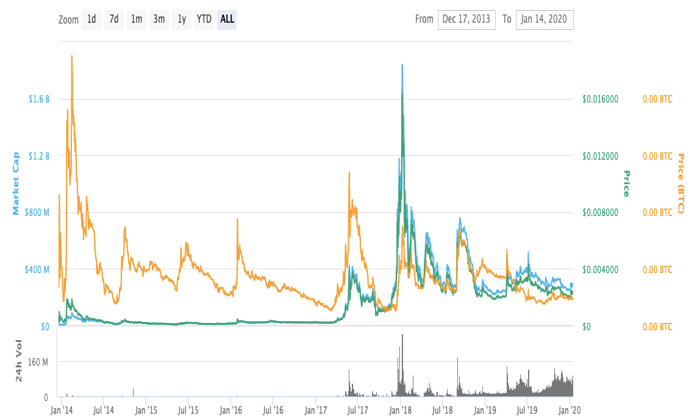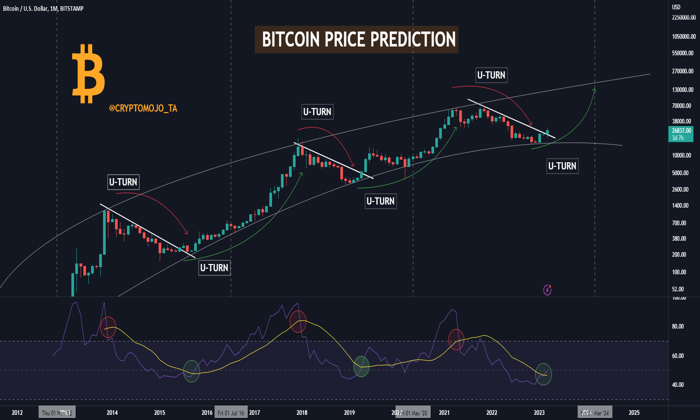In the ever-evolving landscape of cryptocurrency, the Bitcoin market correction is a critical event that all investors are watching closely. After a remarkable surge that saw Bitcoin’s price peak at an impressive $104,300, analysts are now pivoting towards Bitcoin price analysis to forecast potential trends. Utilizing the Elliott Wave Theory, experts suggest that this peak signifies the completion of a fifth wave, thereby hinting at an imminent downtrend. As we delve into the intricacies of Bitcoin trading strategies, understanding these patterns becomes essential for navigating market fluctuations. Thus, keeping abreast of cryptocurrency market trends is vital for making informed decisions in the volatile world of digital assets.
The correction in Bitcoin’s value marks a pivotal moment in its trading saga, reflecting broader dynamics within the digital currency ecosystem. This period of adjustment not only serves as a reflection of investor sentiment but also encompasses the intricacies of price movements that define market behavior. By applying techniques like the Elliott Wave Theory, market analysts aim to decipher these fluctuations and provide insights into future Bitcoin trends. As the leading cryptocurrency faces potential price retreats, adjusting one’s trading strategies to adapt to these corrections is crucial for long-term success. Furthermore, keeping an eye on the anticipated forecasts for Bitcoin can illuminate paths for both short-term traders and long-term investors alike.
Understanding the Recent Bitcoin Market Correction
In light of Bitcoin’s recent volatility, the notion of a market correction has become a critical focal point for investors and analysts alike. Following the impressive climb to over $104,300, coinciding with the completion of the fifth wave in the Elliott Wave Theory framework, the cryptocurrency market now braces for a potential downturn. This correction is not merely a fluctuation; it signals a necessary adjustment to align with broader market trends, reinforcing that even leading assets like Bitcoin are not immune to price retrenchment.
Market corrections in cryptocurrencies are standard phenomena, often reflecting the inherent volatility and speculative nature of digital assets. Analysts anticipate that the upcoming Bitcoin market correction might target Fibonacci retracement levels, such as the 0.5 and 0.618 levels, potentially pushing Bitcoin’s price between $86,000 and $89,000. Such movements are essential for healthy market dynamics and can provide advantageous buying opportunities for investors looking to capitalize on Bitcoin’s long-term bullish trajectory.
Elliott Wave Theory and Bitcoin’s Price Forecast
The Elliott Wave Theory, a pivotal analytical tool in financial forecasting, provides significant insights into Bitcoin’s price trajectory. As Bitcoin surged past the $100,000 mark, analysts employed this theory to ascertain potential future movements. By identifying the completion of the fifth wave, analysts suggest that a correction phase is imminent, establishing a prudent basis for understanding Bitcoin’s forecast. This theoretical framework allows investors to navigate the complex waves of market sentiment and price action effectively.
In practical terms, applying Elliott Wave Theory to Bitcoin reveals a nuanced outlook for future price movements. If the correction unfolds as projected, it will serve as a critical juncture before the anticipated bullish wave V — expected to push Bitcoin prices towards $106,000. Understanding these patterns offers investors not only a glimpse into Bitcoin’s near-term possibilities but also a strategic vantage point from which to implement effective Bitcoin trading strategies in a fluctuating landscape.
Key Cryptocurrency Market Trends Affecting Bitcoin
The cryptocurrency market is continuously evolving, and various trends influence Bitcoin’s performance as the leading digital asset. As developments unfold, particularly those relating to regulations, technological advancements, and market sentiment, Bitcoin remains at the forefront of these changes. Recently, indicators such as a decrease in daily trading volume — which has fallen by 6.68% — suggest shifting investor interest and could foreshadow broader trends impacting the asset’s liquidity and price movements.
These trends, combined with Bitcoin’s historical performance, play an essential role in shaping investor strategy. By closely monitoring the market dynamics, including shifts towards decentralized finance and institutional adoption of cryptocurrencies, investors can define their own trading strategies, positioning themselves advantageously amidst potential volatility. Understanding these trends is crucial, as they influence not only Bitcoin’s price but also the cryptocurrency market at large.
Strategizing for Success in Bitcoin Trading
Navigating the cryptocurrency market requires strategic foresight, especially when trading Bitcoin. Given its current position around $102,810, and the anticipated correction, traders must remain vigilant and informed. Effective Bitcoin trading strategies often blend technical analysis with market sentiment to identify optimal entry and exit points. Utilizing tools like the Fibonacci retracement can help traders predict potential price movements and evaluate risk-reward scenarios while positioning their portfolios accordingly.
Moreover, understanding market corrections as part of a broader strategy can empower traders to capitalize on price dips. For instance, during the predicted correction phase, savvy traders can look for buying opportunities around key retracement levels. Such approaches not only mitigate loss during market fluctuations but can also enhance long-term gains when coupled with informed decision-making and responsive trading actions.
The Role of Market Sentiment in Bitcoin’s Trading Dynamics
Market sentiment is a powerful driver of Bitcoin’s price action, influencing both bullish and bearish trends. Recent analyses from NewThoughtCrypto highlight how sentiment can shift dramatically based on price movements and external factors, such as regulatory news or technological advancements. For instance, investor excitement often spikes following significant price achievements like Bitcoin’s recent surge past $104,300, while corrections can trigger widespread apprehension, prompting traders to reassess their positions.
Staying attuned to market sentiment allows traders to make informed decisions that align with prevailing attitudes. Social media discussions, news articles, and market analysis all contribute to shaping the cryptocurrency landscape. By gauging these sentiments, Bitcoin traders can better anticipate market corrections, adjusting their strategies accordingly to both protect their investments and exploit potential opportunities in an evolving market.
Analyzing Bitcoin’s Price Movements with Technical Indicators
Technical analysis is a cornerstone of trading strategies in the cryptocurrency domain, particularly for Bitcoin. Traders often utilize various technical indicators to interpret price movements and predict future trends. Key tools include moving averages, Relative Strength Index (RSI), and the Fibonacci retracement levels, which have been essential in analyzing Bitcoin’s recent price action. Understanding these indicators enables traders to identify overbought or oversold conditions, guiding them in executing timely trades.
In the case of Bitcoin, the recent analysis utilizing technical indicators has reinforced the perspective of an imminent market correction post-recent highs. By closely monitoring these indicators, traders can determine suitable entry points during corrections, thereby enhancing their positioning ahead of potential bullish runs. Coupling this technical approach with a solid foundation in market fundamentals can yield more robust trading outcomes.
Bitcoin’s Historical Performance and Future Predictions
Bitcoin’s historical performance offers valuable insights into its future price behavior, assisting analysts and traders in making educated predictions. Historically, Bitcoin has displayed cyclical trends characterized by periods of exuberant growth followed by corrections. These patterns have been crucial in formulating predictions, especially when applying theories such as Elliott Wave analysis. The recent rise to an all-time peak signifies a major accomplishment, yet it also sets the stage for potential market corrections.
Future predictions for Bitcoin, particularly in light of current analysis, suggest that the digital asset may experience significant price movements in the upcoming months. Market analysts are particularly focused on the summer months for potential new all-time highs as corrective waves in the interim may set the foundation for sustained bullish trends. By studying past price behavior along with present market conditions, stakeholders can better position themselves in anticipation of Bitcoin’s trajectory.
The Impact of Global Economic Factors on Bitcoin
Global economic factors, including inflation rates, currency strength, and geopolitical tensions, significantly influence Bitcoin’s price dynamics. As a decentralized asset, Bitcoin often attracts investors seeking alternatives amidst traditional market uncertainties. For instance, recent economic instability has fueled Bitcoin’s rise, as more investors view it as a hedge against inflation and currency depreciation, contributing to its impressive price recovery from mid-April lows.
Understanding these global influences allows traders to contextualize Bitcoin’s performance within the larger economic landscape. As economic forecasting indicates ongoing volatility, Bitcoin’s role as a ‘digital gold’ positions it favorably for those engaged in cryptocurrency trading. By recognizing the interconnectedness between systemic economic factors and Bitcoin price movements, investors can enhance their strategic planning when engaging with the market.
Preparing for the Next Bitcoin Rally
As the cryptocurrency market braces for the next potential rally, preparing for Bitcoin’s future price movements requires a strategic mindset. With analysts forecasting a correction phase following the recent high of $104,300, investors must refine their strategies to ride the expected waves of volatility. Successful traders will closely monitor market signals while remaining adaptable to unexpected shifts, ensuring they are well-positioned for the next upward thrust in Bitcoin’s price.
In addition to technical analysis, fostering a long-term investment perspective can be beneficial in navigating the oft-turbulent crypto landscape. Rather than focusing solely on short-term gains, incorporating a broader view that considers Bitcoin’s historical performance and potential for renewed bullish trends can yield significant advantages. Investors who diligently prepare for market fluctuations while maintaining a forward-looking approach will be poised to take full advantage of the next Bitcoin rally.
Frequently Asked Questions
What is a Bitcoin market correction and how does it affect prices?
A Bitcoin market correction is a decline in Bitcoin’s price following an upward trend, indicating that the market is adjusting to prevent overvaluation. Corrections often occur after significant price surges, such as after Bitcoin reached $104,300. Analysts predict that corrections typically target Fibonacci retracement levels, potentially bringing Bitcoin’s price back down to between $86,000 and $89,000 before any new upward momentum.
How can Elliott Wave Theory help in understanding Bitcoin market corrections?
Elliott Wave Theory suggests that Bitcoin’s price movements are predictable and occur in cycles of impulse and correction. After reaching a peak—like the recent $104,300 high—analysts anticipate a correction phase, as outlined in the theory’s five-wave structure. The current market analysis indicates that Bitcoin may complete its fifth wave and then enter a corrective phase, providing valuable insights for traders looking to time their entries and exits effectively.
What can traders expect from the Bitcoin forecast after a market correction?
Post-correction, the Bitcoin forecast suggests a potential bullish trend resuming after a price pullback. Analysts expect that after reaching corrective prices around $86,000 to $89,000, Bitcoin could regain momentum, possibly targeting $106,000 in the next bullish wave. Traders should closely monitor price actions around these levels to determine future trading strategies.
What Bitcoin trading strategies should be considered during a market correction?
During a Bitcoin market correction, traders might consider strategies such as dollar-cost averaging to mitigate risk, or setting buy orders at Fibonacci retracement levels (e.g., between $86,000 and $89,000) to capitalize on lower prices. Additionally, using technical analysis tools like Elliott Wave Theory can inform when to enter or exit trades to maximize potential profits.
How do cryptocurrency market trends influence Bitcoin corrections?
Cryptocurrency market trends play a significant role in Bitcoin corrections as they reflect overall investor sentiment and market dynamics. A bullish trend might lead to rapid price increases, as seen with Bitcoin’s rise to $104,300. When trends reverse, especially due to market speculation or macroeconomic factors, corrections ensue, influencing Bitcoin’s price direction and potentially creating investment opportunities or risks for traders.
| Key Point | Details |
|---|---|
| Recent Price Movement | Bitcoin rebounded from a low of $74,000 in mid-April and surpassed $100,000, reaching as high as $104,300. |
| Market Correction Forecast | Analysts at NewThoughtCrypto suggest that Bitcoin is due for a correction after hitting $104,300, indicating a potential drop to between $86,000 and $89,000. |
| Elliott Wave Theory Analysis | The rise to $104,300 is seen as the peak of the fifth wave, indicating a shift to a corrective phase (A-B-C) to follow. |
| Micro Analysis Insights | Based on the 4-hour chart, Bitcoin has completed waves I, II, and III. Wave IV is expected to be corrective, potentially pushing prices to $100,000 to $101,000 before another bullish wave. |
| Current Trading Status | As of now, Bitcoin is trading at $102,810, reflecting a 0.06% increase in the last day with a trading volume decrease of 6.68%. |
Summary
The Bitcoin market correction is anticipated following a significant price increase, indicating a necessary adjustment period. As Bitcoin surged past $104,300, market analysts predict its corrective phase could draw the price down to levels between $86,000 and $89,000. The forecast aligns with the Elliott Wave Theory, where Bitcoin has completed its impulse waves and is expected to enter a correction before potentially reaching new all-time highs in the upcoming summer.
The recent Bitcoin market correction has become a pivotal topic of discussion among crypto enthusiasts and investors alike. After reaching a remarkable all-time high of $104,300, many are now eagerly analyzing the implications of this price movement using tools such as Elliott Wave Theory. This theory provides insights into potential Bitcoin price analysis, indicating that following this surge, a correction may be on the horizon. As we explore the latest Bitcoin forecast, it’s essential to consider the ongoing cryptocurrency market trends that could influence trading strategies. Navigating this volatile space requires a grasp of the market’s dynamics, especially as traders prepare for possible price adjustments.
Exploring the recent downturn in Bitcoin values brings to light a significant phase in the cryptocurrency’s journey. The price fluctuations post-peak, seen through lens of market analysis tools like Elliott Wave Theory, can guide investors in understanding potential market corrections. As we delve into how these trends impact Bitcoin’s trajectory, the utilization of effective trading strategies becomes increasingly critical. Analyzing the volatility and retracement levels adds clarity to what many are forecasting as the next chapter for Bitcoin. With attention to these underlying mechanisms, stakeholders can better navigate the complexities of the evolving digital asset landscape.
















Leave a Reply